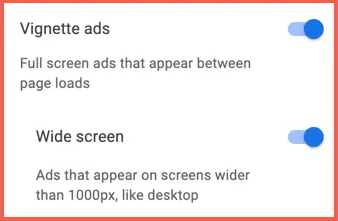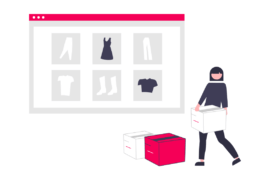Vignette Ads can be effective in capturing the attention of users and delivering a message or call to action. Here’s all about Vignette Ads and how to use them for monetization.
Did you know that just with the help of Vignette Ads, publishers could see a rise of about 5-25% increases in revenue? Also, in comparison to the traditional ad formats, publishers have seen a 4 to 5 times increase in their CPMs.
Vignette Ads are essentially one type of these AdSense Auto Ad formats, which can be put to use for generating more revenue.
Let us discuss at length about Vignette Ads in this article, going over the following topics for better understanding:
- What Really Are AdSense Vignette Ads?
- Why Should Publishers Consider Using Vignette Ads?
- How to Use Vignette Ads for Monetization?
- How to Enable Vignette Ads in AdSense Account?
- Vignette Ad Best Practices
Also Read: Interstitial Ads: Best Practices For Publishers
What Really are AdSense Vignette Ads?

If you are wondering, – What vignette ads are, they can simply be described as one of the most basic Google AdSense ad formats which have been utilized by publishers for a considerable time now to increase their advertisement revenue. These are actually full-page or interstitial ads, which appear in between individual page loads of an app or a website.
Whenever a user goes on to navigate from one page to another, these interstitial ads are meant to pop up. Importantly, users find these Google Vignette Ads only while leaving a web page, not while they land on a page in the initial stage.
Why Should Publishers Consider Using Vignette Ads
Whether it is the desktop or the in-app mode, publishers often tend to find the Vignette Ads to be the best performers when compared to the traditional ads. Therefore, they are also often ready to pay more for these Vignette Ads when necessary. Google Vignette Ads are, in fact, great attention-grabbers when users are busy browsing content.
Since Vignette Ads can be conveniently used across various platforms, including mobile apps, web browsers as well as social networks, the possibility of reaching out to a greater number of viewers is much more. Proportionately, the ROI will also automatically increase beyond a shadow of a doubt.
A more interesting aspect is that these full-screen ads can also be optimized with respect to time and as a result, the CTRs for advertisers keep soaring. It is interesting to note that publishers have seen 5 times growth in their CPMs in comparison to banner ads or other traditional ad formats.
How to Use Vignette Ads for Monetization?

The Vignette Ads are actually by-products of the Google AdSense Auto Ads. They are popular for their ability to leverage the use of Machine Learning in automatically placing ads on various web pages of websites, which are already approved. The choice is automatically made by Google AI regarding the place where the Vignette Ads will be able to perform in the best manner.
Normally, on enabling auto-ads, users usually see full-screen pop-ups on their smartphones while navigating web pages. However, from 3rd Nov 2020 onwards, Google made allowance for these ads to be also available on screens which are wider than 1000px. This gave the publishers an opportunity to attract viewers on wide-screen devices, too, increasing their revenue manifold.
Also Read: 3 Considerations for Publishers to Get the Best Out of Falling Ad Revenue
How to Enable Vignette Ads in AdSense Account?
In order for Vignette Ads to be shown on Desktops, you will need to enable the same in your AdSense Account.
- The First Step is to log in to your Google AdSense Account.
- Next, go to the tab “Ads” and the section “By Site”.
- Click on the Edit Icon by the side of the site where you want the option to be enabled.
- In the “AdSense Settings Preview” Page, check the sidebar on your right. Make sure that the option for “Auto-ads” is enabled for the sites.
- Scroll down and move to the “Ad Formats” Section, where you will be able to enable the option for “Vignette Ads”.
- Along with this, you will also find a “Wide Screen” option. You also need to enable this so that your ads are also visible on a wider screen.
- Next, to save the changes, click on the “Apply to Site
Once these steps are finished, the Vignette Ads will be activated immediately on the respective site. You need to remember here that there is no option to disable the ads on mobile devices and enable them exclusively on the larger screens. They have to be enabled on both mobile as well as larger screens.
Vignette Ads Best Practices
It is true that Vignette Ads are mostly user-friendly and can be easily skipped by users. However, there are still certain things to be considered to ensure best practices:
- As already discussed, as per the latest update of Google, Vignette Ads will now be visible on larger screens as well. So check the size of your ad and ensure that you are presenting it to the viewer in the most precise and detailed manner.
- In order to ensure a seamless user experience, Google AdSense has put a limit to the number of Vignette Ads per user. So grab the only chance you have and make sure that your ad is attractive enough to catch the attention of the viewers.
- If you can create a detailed view of the ad, you will be able to generate more revenue and, at the same time, also maintain a good user experience.
Are You Ready to Enable Vignette Ads?
As is already evident, once you enable Vignette Ads, you will automatically see an improvement in revenue based on the number of views on pages that you receive for your site. So it is quite a useful tool which will help you see positive changes in your revenue with every report.
With the AdPushup ad revenue optimization platform, you can take your ad monetization to the next level. Trusted by more than 300 publishers across 50+ countries, we help gain an average ad revenue uplift of over 50%.
To start enabling vignette ads on your website, get started here.
FAQ – Vignette Ads
A vignette ad is a type of display ad that appears as a full-screen overlay on a website or mobile app. It typically appears as a pop-up or modal window and can include various types of media, such as images, videos, and interactive elements.
Vignette Ads are typically served through ad networks or ad exchanges, which use cookies or mobile advertising IDs to target the ads to specific users based on their browsing history or demographics. When a user visits a website or app that is part of the ad network, the vignette ad is triggered to display.
Users can opt-out of receiving Vignette Ads by adjusting their browser settings to block or disable cookies or by using a mobile ad blocker app. They can also opt out of receiving targeted ads from specific ad networks by visiting the Network Advertising Initiative’s (NAI) opt-out page or the Digital Advertising Alliance’s (DAA) opt-out page.
Vignette Ads, like all forms of online advertising, must comply with relevant laws and regulations. This includes regulations related to data privacy, such as the General Data Protection Regulation (GDPR) in the European Union and the California Consumer Privacy Act (CCPA) in the United States.

Shubham is a digital marketer with rich experience working in the advertisement technology industry. He has vast experience in the programmatic industry, driving business strategy and scaling functions including but not limited to growth and marketing, Operations, process optimization, and Sales.





![28 Best Supply Side Platforms (SSP) for Publishers in 2024 [The Complete List] Supply Side Platforms](https://www.adpushup.com/blog/wp-content/uploads/2022/05/undraw_chore_list_re_2lq8-270x180.png)

